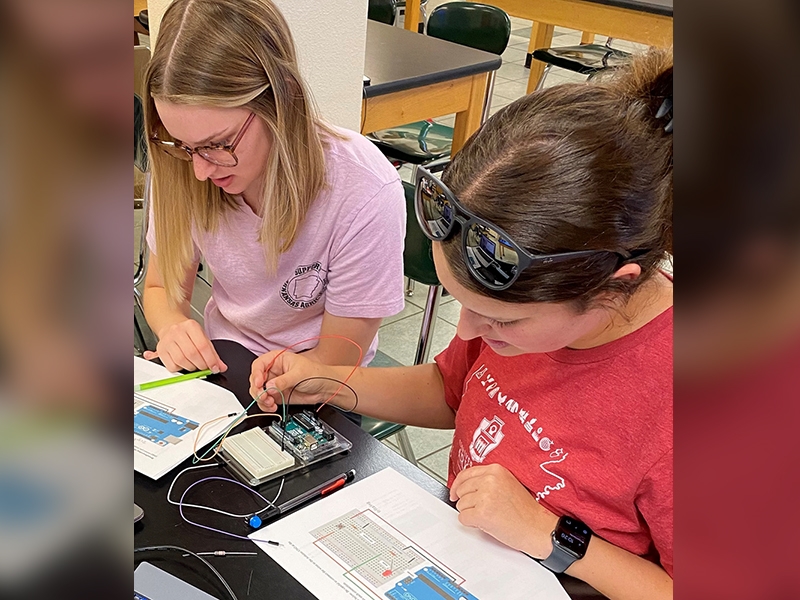Agricultural Systems Technology Management Concentration Recognized Nationally
Agricultural Systems Technology Management Concentration ... University of Arkansas Newswire


Agricultural Systems Technology Management Concentration Earns Continuing Recognition
July 28, 2023

submitted
ASTM students Gracie Hewat (left) and Caitlyn Simon are completing a microcontroller breadboarding and programming assignment in the Mechanized Systems Management class.
The agricultural systems technology management concentration in the Dale Bumpers College of Agricultural, Food and Life Sciences at the University of Arkansas has recently earned “continuing recognition as a technology management program” status from the American Society of Agricultural and Biological Engineers (ASABE).
ASABE Recognition
The announcement of the continuing recognition was made at the ASABE 2023 annual international meeting in Omaha, Nebraska. ASABE recognizes ASTM programs that meet specific quality standards related to curriculum requirements, graduate placement, facilities and equipment, faculty quality, and institutional support.
Coordinated by University Professor Don Johnson
The ASTM concentration is coordinated by University Professor Don Johnson. According to Johnson, ASABE program recognition assures students and employers that graduates are learning the technical and management skills necessary for success in a wide variety of technology-oriented agricultural careers. ASTM graduates are typically employed in technical sales, service, and management careers.
Program Recognition Process
Program recognition is based on detailed documentation submitted by the department and a meeting with representatives of the ASABE’s EOPD-206 (Agricultural Technology & Management Curriculum Review & Program Recognition) Committee. The status is valid for six years, extending through 2029.
Part of the Department of Agricultural Education, Communications and Technology
The ASTM concentration is part of the Department of Agricultural Education, Communications and Technology at the University of Arkansas.
Arkansas’ Only ASABE Recognized Program
The U of A ASTM concentration is the only ASABE recognized program in Arkansas. ASABE, founded in 1907, is an educational and scientific organization dedicated to the advancement of engineering applicable to agricultural, food, and biological systems.
About the Dale Bumpers College of Agricultural, Food and Life Sciences
Bumpers College provides life-changing opportunities to position and prepare graduates who will be leaders in the businesses associated with foods, family, the environment, agriculture, sustainability, and human quality of life; and who will be first-choice candidates of employers looking for leaders, innovators, policy makers, and entrepreneurs.
About the University of Arkansas
As Arkansas’ flagship institution, the University of Arkansas provides an internationally competitive education in more than 200 academic programs. Founded in 1871, the U of A contributes more than $2.2 billion to Arkansas’ economy through the teaching of new knowledge and skills, entrepreneurship and job development, discovery through research and creative activity while also providing training for professional disciplines. The Carnegie Foundation classifies the U of A among the few U.S. colleges and universities with the highest level of research activity. U.S. News & World Report ranks the U of A among the top public universities in the nation.
SDGs, Targets, and Indicators Identified in the Article
| SDGs | Targets | Indicators |
|---|---|---|
| SDG 4: Quality Education | 4.3: By 2030, ensure equal access for all women and men to affordable and quality technical, vocational, and tertiary education, including university | No specific indicators mentioned in the article |
| SDG 8: Decent Work and Economic Growth | 8.5: By 2030, achieve full and productive employment and decent work for all women and men, including for young people and persons with disabilities, and equal pay for work of equal value | No specific indicators mentioned in the article |
| SDG 9: Industry, Innovation, and Infrastructure | 9.5: Enhance scientific research, upgrade the technological capabilities of industrial sectors in all countries, in particular developing countries, including, by 2030, encouraging innovation and substantially increasing the number of research and development workers per 1 million people and public and private research and development spending | No specific indicators mentioned in the article |
1. Which SDGs are addressed or connected to the issues highlighted in the article?
SDG 4: Quality Education
The article mentions the recognition of the agricultural systems technology management concentration program by the American Society of Agricultural and Biological Engineers (ASABE). This recognition assures students and employers that graduates are learning the technical and management skills necessary for success in technology-oriented agricultural careers. This aligns with SDG 4, which aims to ensure inclusive and quality education for all.
SDG 8: Decent Work and Economic Growth
The article mentions that graduates of the ASTM concentration program are typically employed in technical sales, service, and management careers. This demonstrates the connection to SDG 8, which aims to promote sustained, inclusive, and sustainable economic growth, full and productive employment, and decent work for all.
SDG 9: Industry, Innovation, and Infrastructure
The article highlights the recognition of the ASTM program by ASABE, which signifies that the program meets specific quality standards related to curriculum requirements, facilities and equipment, and faculty quality. This aligns with SDG 9, which aims to build resilient infrastructure, promote inclusive and sustainable industrialization, and foster innovation.
2. What specific targets under those SDGs can be identified based on the article’s content?
Target 4.3: By 2030, ensure equal access for all women and men to affordable and quality technical, vocational, and tertiary education, including university
The recognition of the ASTM program indicates that it provides quality technical education in the field of agricultural systems technology management. This contributes to achieving target 4.3 by ensuring equal access to affordable and quality technical education.
Target 8.5: By 2030, achieve full and productive employment and decent work for all women and men, including for young people and persons with disabilities, and equal pay for work of equal value
The employment outcomes of graduates from the ASTM program demonstrate progress towards target 8.5. Graduates are typically employed in technical sales, service, and management careers, which contribute to full and productive employment and decent work.
Target 9.5: Enhance scientific research, upgrade the technological capabilities of industrial sectors in all countries, in particular developing countries, including, by 2030, encouraging innovation and substantially increasing the number of research and development workers per 1 million people and public and private research and development spending
The recognition of the ASTM program by ASABE indicates that it meets specific quality standards related to curriculum requirements and faculty quality. This demonstrates progress towards target 9.5 by enhancing scientific research and upgrading the technological capabilities of the agricultural sector.
3. Are there any indicators mentioned or implied in the article that can be used to measure progress towards the identified targets?
No specific indicators are mentioned or implied in the article that can be used to measure progress towards the identified targets. However, the recognition of the ASTM program by ASABE serves as an indicator of the program’s quality and alignment with industry standards.
4. SDGs, Targets, and Indicators
| SDGs | Targets | Indicators |
|---|---|---|
| SDG 4: Quality Education | 4.3: By 2030, ensure equal access for all women and men to affordable and quality technical, vocational, and tertiary education, including university | No specific indicators mentioned in the article |
| SDG 8: Decent Work and Economic Growth | 8.5: By 2030, achieve full and productive employment and decent work for all women and men, including for young people and persons with disabilities, and equal pay for work of equal value | No specific indicators mentioned in the article |
| SDG 9: Industry, Innovation, and Infrastructure | 9.5: Enhance scientific research, upgrade the technological capabilities of industrial sectors in all countries, in particular developing countries, including, by 2030, encouraging innovation and substantially increasing the number of research and development workers per 1 million people and public and private research and development spending | No specific indicators mentioned in the article |
Behold! This splendid article springs forth from the wellspring of knowledge, shaped by a wondrous proprietary AI technology that delved into a vast ocean of data, illuminating the path towards the Sustainable Development Goals. Remember that all rights are reserved by SDG Investors LLC, empowering us to champion progress together.
Source: news.uark.edu

Join us, as fellow seekers of change, on a transformative journey at https://sdgtalks.ai/welcome, where you can become a member and actively contribute to shaping a brighter future.







